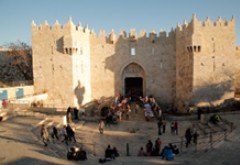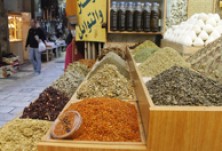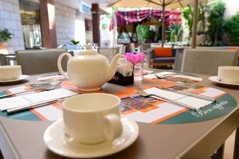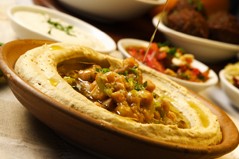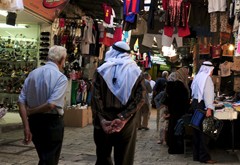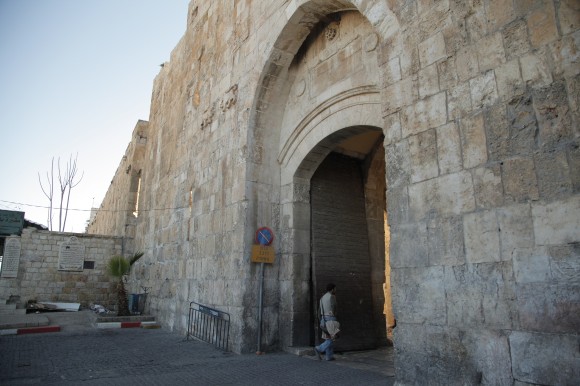Location
Bab al-Asbat is the only gate that has been open in the eastern part of the Jerusalem Wall from the time of its construction until today. The gate was linked to a group of myths that have no basis in truth and that contradict historical facts. Bab al-Asbat is accessible through an inclining road from Wadi Qadrun (Wadi Juhannam), which separates two Islamic cemetaries, known as Bab al-Rahma (Gate of Mercy) cemetery to the south, and al-Yusufiyya cemetery, named after Yousef Ibn Shadi, better known as Salaheddin al-Ayyubi (Saladin), to the north.
Names
Bab al-Asbat was known by a variety of names, most of which are still used these days. In addition to Bab al-Asbat, some of these names are Bab Sitna Mariam (Mother Mary Gate), Bab Al-Qiddis Stephan (St. Stephen’s Gate), and Bab l-Usud (Lions Gate), in addition to the other names of Bab al-Ghanam (Sheep’s Gate), Bab al-Ghuwr (Jordan Valley Gate) and Bab Ariha (Jericho Gate). Its name of Bab al-Asbat is indicative of the principles of tolerance and absence of bigotry on the part of Muslims, who never hesitated to name buildings and places after prophets and personalities of Judaism and Christianity. The Holy Quran referred to this tolerance:
‘The Messenger [Prophet] believes in what has been sent down to him from his Lord, and [so do] believers. They all believe in Allah, and His angels, His scriptures and His messengers. Theysay ‘We do not differentiate between any of His messengers’’ [al-Baqara, 285].
The gate was also famously known as the Lions Gate, due to the statues of four lions: two north and two south of the gate’s lintel. These lions constituted the emblem of the Mamluk Sultan Baibars (1260-1277 AD / 658-676 H), which was used on all his properties of buildings, coins and tools of that era.
The lions were moved from the ruins of the Khan that was established by al-Zhahir Bibars in Jerusalem to the southwest of Bab Al-Khalil, where the old railroad station was located.
Myths of the Lions of Bab Al-Asbat
Several myths revolved around the lions of Bab Al-Asbat. One myth said that these lions were going to devour Sultan Salim, the father of Sultan Suleiman I (Suleiman Al-Qanuni), if he attempted to destroy Jerusalem. Needless to say, this myth is unworthy of any comments due to its weak claim and its contradiction with the historically proven actions and respect that Sultan Salim had towards Jerusalem. It was said that he was overjoyed at the conquest of Jerusalem, as it is the first site of pilgrimage for Muslims. It was also said that scholars and the pious went out to welcome Salim Shah and hand him over the keys to al-Aqsa Mosque and the Dome of the Rock. He then offered gifts to all the notables of the city, exempted them from high taxes and confirmed their job positions. According to Wikipedia, Suleiman had placed these lions in celebration of the victory of the Ottomans over the Mamluks in 1517 AD. Yet, there are more than two decades between the time of the Battle of Marj Dabeq and the construction of Bab al-Asbat, which ultimately refutes this claim, in addition to the fact that Salim was the one who defeated the Mamluks and not Suleiman. Wikipedia continues with its errors, saying that Suleiman placed these lions after a dream he had about being attacked by lions was interpreted as being due to his high taxation policy.
Turkish traveler Eviliya Celebi in 1671 AD (1082 H) told a story explaining why Sultan Suleiman I (Suleiman al-Qanuni) (1520-1566 AD / 926-972 H) was interested in Jerusalem. He attributed this interest to a dream that the sultan had in which Prophet Muhammad told him: ‘I order you to disperse funds on decorating Mecca and Medina and on fortifying the Jerusalem citadel to fend off the infidels when they try to overtake Jerusalem in the eras of your successors. You must decorate its Haram [Holy Sanctuary] by building a sabil [fountain] in it, grant its dervishes annual funds, decorate the Dome of the Rock and rebuild Jerusalem.’
More than a decade separates Sultan Suleiman I’s era and Celeibi’s writings. As such, this story must be taken with caution, because it represents the knowledge of Celebi’s era; in addition, there were other, practical and religious reasons, discussed by many experts, that made Sultan Suleiman I pay attention to Jerusalem and its architecture. After all, his era was a golden one for Jerusalem and his architecture continues to stand witness to his extreme care and attention towards the city.
Indeed, this story has seen changes, where the appearance of Prophet Muhammad in the dream was replaced by the appearance of the four lions, cutting the sultan into pieces. When he asked for an interpretation of the dream, he was told that this was the result of the wrath of God, because the sultan did not show interest in the city of Jerusalem and neglected its state of broken walls and its burnt castle. Consequently, the sultan gave orders to begin work in the city. Its walls were renovated, the gates were opened and the lions were carved on Bab al-Asbat. There is little doubt that this myth has no basis in truth. It was circulated in the second half of the 19th century to provide an interesting explanation for the lions on the façade.
Founder
Bab al-Asbat has a foundation plaque pinned on its interior southern façade. The plaque, which is 80 x 40 cm, is in good condition, although the second line of the inscription is faded in some areas. The inscription is written in Ottoman style and reads:
Has ordered the construction of this blessed Wall, our Master, the sultan Sulieman, son of sultan Salim Khan, may Allah perpetuate his reign and his sultanate, on the date of the year 945 (1538-1539AD).
Façades
Bab al-Asbat has three façades: a rich, eastern façade facing who approaches the Old City, and western and southern façades that are predominantly simple in design. The eastern façade has a huge stone face, its lower section rising 11 courses, and was constructed from large rough stones. In the center of this façade, an entrance was opened, topped by a straight lintel composed of 13 stones. Directly above the lintel, a rectangular stone plaque was placed, but without any inscription on it, suggesting that it was for decorative purposes like other plaques found on the Wall and in other Ottoman architecture. The plaque is flanked on the northern and southern sides by stone discs without decoration, on top of which is a bossed stone with a hollowed geometrical relief. The entrance is crowned by a large, pointed lintel, surrounded by the protruding engraving of four lions, two on each side and facing forward. The engraved lions show power and agility, particularly in the facial expressions and the paws, as well as the tails of each lion, although the pair of lions on the northern side is suffering from some level of erosion. There are also five arrow slits in the eastern façade of Bab al-Asbat for observation and archery purposes.
Plan
Like other gates of the Jerusalem Wall, Bab al-Asbat was designed at a slant and a right angle, to hinder and expose attackers if they succeeded in penetrating the main gate. Today, it is possible to walk straight through the gate, since the wall opposite the entrance was removed to facilitate the passage of cars. This was probably done during the British Mandate. Several machicolations were set up above the entrance to throw materials and to hinder potential attackers.
At this point, the visitor may decide to conclude the tour of the Wall, in which case s/he may enter the Old City through al-Mujahidin Street to start on other trails or visit al-Aqsa Mosque. If the visitor wishes to continue on the entire trail of the Jerusalem Wall, the path moves along through Bab al-Rahma cemetery, with a view of the Mount of Olives. The sheer size of the stones in this part of the eastern Wall must be noted, given that the wall of al-Aqsa Mosque and the Jerusalem Wall join together a few meters from Bab al-Asbat. At this point in the trail, the tombstones of ‘Ubada ibn al-Samet and Shaddad Bbn Aws (companions of the Prophet Muhammad) can be seen. Moving along the façade of Bab al-Rahmah and Bab al-Tawba (Golden Gate), the trail continues south. Looking up to the top of the Wall, a prominent column, known as al-Sirat, comes into view. A few meters later, the trail reaches the southeastern part of the Jerusalem Wall and the wall of al-Aqsa Mosque. Here, the visitor must take the paved road to reach Bab al-Magharibah (Dung Gate) in the southern part of the Wall. The road here begins to slope upwards, complying with the city’s topography.

